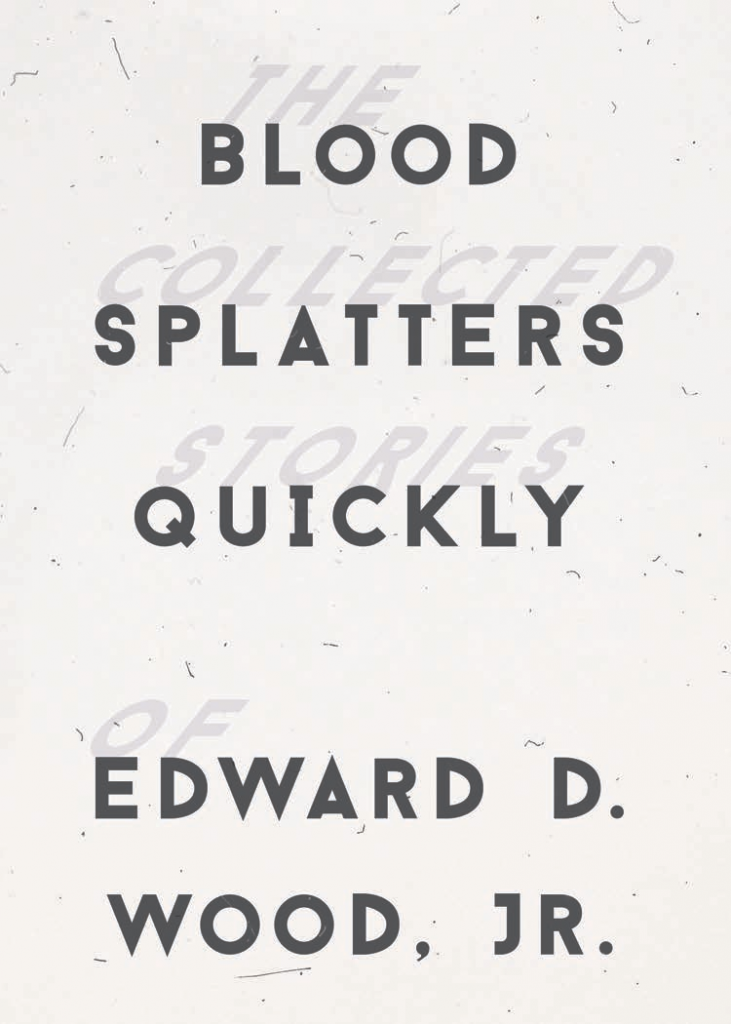 |
| Review by David E. Goldweber |
Filmmaker Stephen Apostolof, in an interview included on Rhino’s Orgy of the Dead DVD, admitted that Ed Wood had “no concept” about directing films but insisted that Wood was a good writer.
Could Apostolof be right? Watching Plan 9 from Outer Space, we might debate whether Wood was any good at writing screenplays.
But now, reading Wood’s short stories in Blood Splatters Quickly, we’ll be forced to agree that the guy at least was good at producing slick pulp fiction.
Wood’s stories are being collected in a single 300+page volume: Blood Splatters Quickly: The Collected Stories of Edward D. Wood, Jr. from OR Books, with a helpful introduction by Bob Blackburn, longtime friend of Wood’s widow, Kathy.
Most of these stories have never been reprinted since they initially appeared back in 1969-1974.
There are 33 stories total, each running approximately 2000 words.
As we learn from the introduction – and as Wood fans should already know – Wood turned to writing in the early 1960s after failing as a film director. He sold a few screenplays (most notably Orgy of the Dead and One Million AC/ DC) but could scarcely pay his bills, so he eventually churned out a series of pulp stories to sell to Bernie Bloom, publisher of Pendulum Publishing’s girlie magazines. The magazines have long been forgotten, but now the stories have new life.
So how are the stories?
None are what we would call high art, but most of them undeniably achieve what they aim for: they are catchy, and punchy, and fast. Sometimes they’re even funny and surprising.
The moods and subjects of the stories vary greatly. Some are exploitative smut (like “The Autograph” or “2 X Double”), and some are bloody and perverted (like “The Gory Details” or “Breasts of the Chicken”), but a few of them attempt serious social commentary (“Scene of the Crime”) or character development (“The Wave Off”). One of them – the most serious of the bunch, “Pray for Rain” – wouldn’t be far out of place in a Norton literature anthology.
As for Wood’s writing, it deliberately uses run-ons or fragments for fast reading. Many lines and paragraphs are short, many sentences using dashes or ellipses for easy scanning or skimming. It’s a familiar and effective style for pulp fiction. One can detect EC Comic-style snap endings, where villains are hoist in their own petard.
One senses Edgar Allan Poe’s influence in the horror stories, with the borderline-insane first-person narrators asking rhetorical questions to suggest unknown terrors: what was it that drew me to that cemetery? what was that shape that moved past me in the night? what was that strange sensation that I could not remember?
Most of the stories have some mixture of sex and gore. Several are funny, but others are angrier than some readers might prefer. Though all were hastily written, they are written clearly enough, with beginning, middle, and end. Many foreshadow their endings with suggestions and suspense.
None of the stories – even the weaker ones like “Island Divorce” or “Private Girl” – is a disaster. If you’re looking to laugh at Ed Wood, look elsewhere.
My favorite stories were the few that aimed for serious horror atmosphere.
In “Dracula Revisited,” the obsessed protagonist ventures to Dracula’s castle to see if the legends are real. He encounters all sorts of odd creatures and illusions: “Deep in that blackness there seemed to float four white gauze-covered creatures, all with very long white hair. I could not make out clearly any features. If I had and were to describe them, I could only illustrate by saying the faces were skulls with shocking white skin pulled tightly across the bone.”
“The Night the Banshee Cried” has more of this horror atmosphere: “And those screams … the screams of the damned. Do they come from the right of me? The left? Are they coming from all the directions at the same time? Or are they coming from those tortured souls who still remain below the sod being once more tortured by the lightning which seeps through to the very tops of their coffins?”
In “I, Warlock,” horror mixes with exploitation, as the warlock-protagonist declares: “Degeneracy runs rampant! Call down the degenerates! Bring out the tears and the sorrows of despair!”
More fun exploitation comes in stories such as “Hellfire” which is mostly a description of the Devil having sex with prostitutes. We learn that “The Devil thrives with and in fire… The more tremendous the fire, the more lust crazed he becomes… the more in demand he is for the depraved, the degenerates, the deviants and the prostitutes.” Later, the Devil declares: “All the world is naked! When one has Lived, all must be naked!”
As for Wood’s trademark loopy dialogue, you can find a good example in “To Kill a Saturday Night” when one farm worker convinces another that sweating makes us cleaner. “Sweat is water, ain’t it? And they say that salt is the best thing ever invented for making somebody clean. So sweat has got salt in it and when we sweat a lot we’re taking a shower right out there in the field.”
It’s hard not to read many of the stories autobiographically.
Wood was an impoverished alcoholic, unlucky and outcast. He was a married heterosexual, but he lived a double life as a transvestite. Accordingly, you’ll notice a continuing sympathy with poor people, strippers, prostitutes, gays, lesbians, alcoholics, and others on the margins of American society in the late 60s and early 70s.
Sometimes the sympathy mixes with exploitation (as in “Superfruit” which describes a gay guy whose only marketable skill is gay sex). But it’s certainly there. Several stories – such as “Flowers for Flame Lamarr” or “No Atheists in the Grave” – seem to be leading toward an explosive unhappy ending but instead conclude on a sympathetic soft note.
For those of you wondering if Wood’s famous angora fetish might have waned in his later years, wonder no more: the fetish actually seems to have increased. No less than five stories specifically mention angora sweaters worn by young ladies, and a sixth story even sports “Ann Gora” as a pseudonym!
So how does this collection change our attitudes about Wood? It forces us to admit that Ed Wood, while incompetent as a film director, was skilled as a pulp writer. I mean no disrespect here. There is an art to the pulp story, as there is an art to the B-movie.
Wood’s impulsiveness prevented him from learning the art of directing. But this same impulsiveness helped him create these breezy, nutty, short pulp stories. He’s aiming lower – but he’s hitting his mark.
When these stories are funny, they’re SUPPOSED to be funny, so – after all these years – we’re finally laughing WITH Ed Wood rather than AT him. Reading Blood Splatters Quickly, you’ll be impressed by, and even proud of, Edward D. Wood, Jr.






































































































2 Comments
You must be logged in to post a comment Login